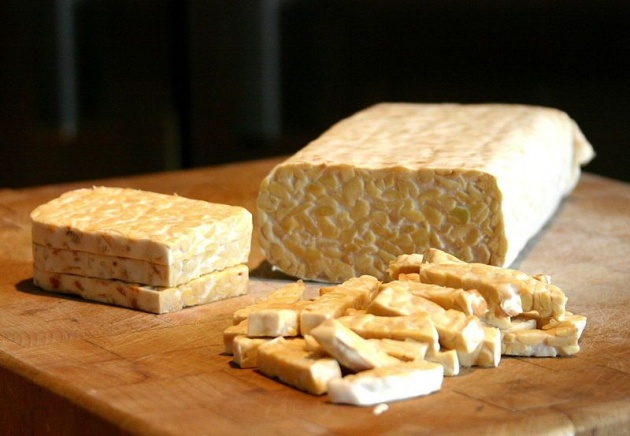
Tempe is a food made from the fermentation of soy beans or some other material that uses some kind of Rhizopus, such as Rhizopus oligosporus, Rh. oryzae, Rh. stolonifer (bread mold), or Rh. arrhizus. The preparation of this fermentation are generally known as "tempeh".
Mold that grows on hydrolyze soy complex compounds into simpler compounds that are easily digested by humans. Tempe is rich in dietary fiber, calcium, vitamin B and iron. Various kinds of content in tempeh have medicinal value, such as antibiotics to cure the infection and degenerative disease preventing antioxidants.
In general, tempeh is white because mycelial growth of mold that holds the seeds of soybean, forming a solidified texture. Degradation of the components making tempe fermented soy has a distinctive flavor and aroma. Unlike the tofu, tempeh feels a bit sour.
Tempe widely consumed in Indonesia, but now has worldwide. Vegetarians around the world many of which have been using tempeh instead of meat. As a result now tempeh produced in many places in the world, not only in Indonesia. Various studies in a number of countries, such as Germany, Japan, and the United States. Indonesia is also now trying to develop strains (strains) to produce a superior Rhizopus tempe faster, quality, or improve the nutritional content of tempe.
Tempe wrapped in banana leaves are sold in traditional markets Indonesia
There are various methods of making tempe. [1] [2] However, the technique of making tempe in Indonesia generally consists of the stages of boiling, peeling, soaking and pickling, washing, inoculation with yeast, packaging, and fermentation. [3]
In the early stages of making tempeh, soy beans boiled. This boiling stage serves as a hydration process, namely that of soy beans absorb as much water as possible. Boiling is also intended to soften soybeans that will be able to absorb the acid in the immersion phase.
Skin soy beans shelled on stage stripping in order to be able to penetrate the fungal mycelium soybean seeds during fermentation. Peeling can be done by hand, trampled by foot, or by seed skin peeler.
Once peeled, soaked soy beans. The goal is for the immersion phase hydration of soy beans and let the natural lactic acid fermentation in order to obtain the necessary acidity for the growth of fungi. Lactic acid fermentation occurs characterized by the emergence of a sour smell and scum on the water immersion due to the growth of Lactobacillus. When the growth of lactic acid bacteria is not optimal (eg in subtropical countries [4], the acid should be added to the soaking water, lactic acid fermentation and acidification, it is also beneficial to increase the nutritional value and eliminate toxic bacteria.
The end of the washing process carried out to remove impurities that may

Inoculation is done with the addition of inoculum, ie tempeh or laru. Inoculum may be a mold that grows on leaves and dried hibiscus or teak leaves (called usar; traditionally used), tempeh mold spores in the medium flour (wheat, rice, or tapioca; sold in the market), or pure culture of R. oligosporus (commonly used by outside Indonesian tempeh maker). [4] [5] Inoculation can be done in two ways, namely (1) stocking inoculum on the surface of the soybeans are already cold and dried, then mixed evenly before wrapping; or (2) the inoculum can be mixed directly at the time of immersion, left for some time, and then dried.
Soybean seeds that have been wrapped allowed to undergo a process of fermentation. In this process the mold growing on the surface and penetrate the seeds of soybean, incorporate them into tempeh. Fermentation can be carried out at a temperature of 20 ° C-37 ° C for 18-36 hours. Shorter fermentation time is usually for tempeh uses many inoculum and higher temperatures, while the traditional process using laru of leaf fermentation usually takes up to 36 hours.



